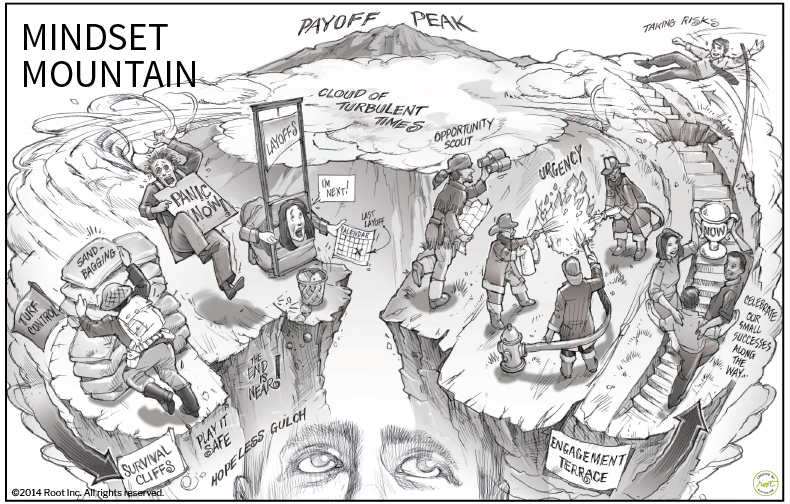Some companies emerge from an economic downturn stronger and more highly valued than they were before the economy soured. The big differentiator that separates them from companies that falter is people… how their leaders engage, motivate, and capitalize on their talents and knowledge in the face of adversity.
The critical first step in making sure that people don’t jump on “the freakout train” of doom and gloom is to truly identify with their initial mindset. But how do you tell people that they’re more important than ever after you’ve just laid off 15% of their colleagues?
The Root Watercooler® sketch at the center of this blog is titled “Mindset Mountain.” On the left, we see the natural and absolutely destructive behaviors that kick in during bad times. In essence, people are typically trapped on three “Survival Cliffs” – the emotions of control, fear, and anxiety. The focus shifts from team performance to self-preservation, and this is exactly the opposite of what’s needed! At a time when we need people to contribute their best, we often see the worst. At a time when information is vital, organizations go silent. And at a time when we need to take smart risks, people become more conservative than ever and play it so safe that it accelerates more negative outcomes.

Engaging people in turbulent times requires leaders to be aware, care, and be regularly engaged in truth telling. One of General Colin Powell’s leadership lessons applies well here: “The day soldiers stop bringing you their problems is the day you stop leading them. They have either lost confidence that you can help them or have concluded that you don’t care. Either case is a failure of leadership.”
The key is to use the adversity to engage your people (see the “Engagement Terrace” on the sketch) to constantly define reality, communicate the score, use urgency as an alignment ally, scout the possibilities, and celebrate small victories.
- Define Reality. People are amazingly able to deal with reality even if it has a downside, but the unknown is paralyzing. The leader’s job is to bring the facts of “exactly where we are” to the workforce. Not only can most people handle it, but they crave it in times of economic trouble. Uncertainty has greater negativity than the bad news itself. That’s why accurate “big picture” news becomes an important tool. Providing the context of actions, or the “whys,” is essential.
- Communicate the Score. More than ever, people are interested in costs, sales, and financial strength as a measure of “how we’re doing.” Use this curiosity and interest to better immerse all employees in the metrics of the business. Leaders need to balance the tension of “what’s real” with “what’s possible.”
- Use Urgency as an Alignment Ally. Instead of looking at change like a near-deathbed crisis lurking just around the corner, accelerate your efforts to immediately analyze and act on problems instead of wandering around it. Urgency can better frame the challenges, engage people in a deeper understanding of the issues, and equip them with the responses necessary to be successful.
- Scout the Possibilities. Deputize your people as “opportunity scouts.” Doing so means tapping into what your people know about the current challenges and getting them involved in imagining a response and a recovery plan that creates value in the current environment. No matter how intensive past productivity efforts have been, people can always see more opportunities when they are engaged in the “why” and the “what,” and then given a chance to suggest the “how.”
- Celebrate Small Victories. This means even more recognition of the adaptive actions that are getting positive results. Don’t over-hype the small gains, but in baseball lingo, it’s the singles and doubles that allow you to emerge stronger and persevere throughout the game.
As leaders, we need to ask ourselves these questions: Am I defining reality and creating hope in this economic downturn? Am I helping my people to become the change agents that we need them to be so we can thrive in difficult times? And do they truly know the score so they can actively engage in improving it?
Looking for additional insights on driving change?






